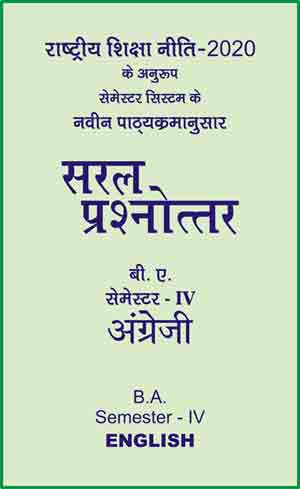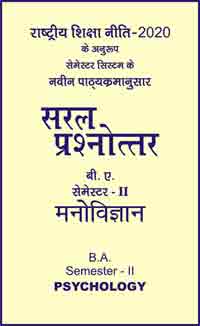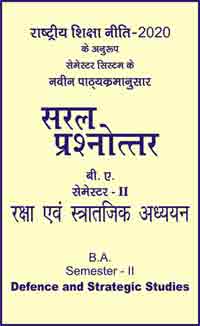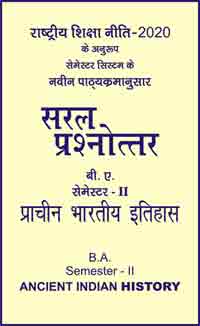|
बी ए - एम ए >> बीए सेमेस्टर-4 अंग्रेजी बीए सेमेस्टर-4 अंग्रेजीसरल प्रश्नोत्तर समूह
|
5 पाठक हैं |
|||||||
बीए सेमेस्टर-4 अंग्रेजी - सरल प्रश्नोत्तर
Unit-VI: Drama
Chapter - 10
Mohan Rakesh : Aadhe Adhure (Halfway House)
Brief Introduction
Mohan Rakesh's play 'Aadhe-Adhure' portrays the internal strife and tangled relationships of a middle-class family, as well as the changing environment between men and women in society and the expectations of both from each other.
Mahendranath has been sitting idle at home after failing in business for a long time and his wife Savitri runs the house after doing a job. Due to various circumstances and their respective nature both of them hate each other but still they are forced to live together due to the social familial and customary structures. The living together of Mahendranath and Savitri in spite of hatred for each other, reflects the customary compulsions prevailing in the Indian society, due to which even a man of a male-dominated society finds himself unable to break the bond of marriage.
Savitri sees Mahendranath as always a submissive, personality less and dependent person who has no respect in her eyes. She does not expect such a man as her life partner for herself or for life. That's why she gets cut off from him and keeps on looking for a perfect man who can live up to all her criteria, but she does not find such a man anywhere Sometimes finding some characteristics of such a person in a person, she is attracted towards others, but with the passage of time, she is always disappointed after finding something or the other Savitri's constant search for a perfect man outside thus resulting from her husband's disappointment is also a sign of a new self-centred attitude of women towards their lives.
On the other hand Mahendranath feels that Savitri always tries to dominate him and humiliate him She always wants to control him. He repeatedly tries to get away from her, but is so dependent on her that he has to come back every time.
After marrying Savitri, the friend's favorite and cheerful, Mahendranath has become a loser after constantly failing in business, beating him up. leaving home when his wife's acquaintances- lovers come home. Most humiliated, he goes to the place of his childhood friend Juneja that he will never return home. But in the end it comes back only in bad condition of blood pressure. He can neither live with Savitri nor separate.
It can be said that both of them are looking for another partner. Both of them are half in themselves, incomplete and their current partner does not reduce this incompleteness, but increases the feeling.
This situation in itself is a tragic form of the male-female relationship. From the point of view of the playwright, it seems that under any circumstances there can never be any harmony or permanent harmony in the relationship between men and women, Men and women relations move forward with such a contradiction where it is difficult to live together and also to separate. Both are forced to lead a half-life like this.
This situation portrays the change in the relationship between men and women in the modem middle-class society, where in the absence of ambitions, self-centred nature and self-reliance, the relationship which should be the basis of life, becomes a burden. And men and women find themselves compelled to carry that burden for life.
The main reason for this emotional separation between Mahendranath and Savitri can also be understood as their economic condition. But playwright Mohan Rakesh has also shown through other characters that financial crisis is not always the only reason for husband-wife separation and family breakdown. The married life of Savitri's daughter Binny and her husband Manoj is financially sound, yet the tension between them and the suffocation in their relationship proves the above statement.
Apart from Mahendranath, Juneja, Shivjit Jagmohan, Manoj and Singhania have also been mentioned in the play. The social and economic status of these characters was quite different from that of Mahendranath and this can be considered as one of the reasons why Savitri was attracted to some of these characters, but was still unable to form a lasting relationship that would end her imperfection. This shows that the man of the middle class society nowadays looks for the convenience while making the relationship and when that facility ends then there is no reason for the relationship to continue. In this change coming very fast, the male-female relationship also changes its form and shape. This is the reason why the play 'Aadhe-Adhure' exposes the failures, unfulfilled ambitions, sexual frustrations and fear, hatred and resentment in the relationship between man and woman.
Mental separation and discord between husband and wife also affects their other relationships Mahendranath and Savitr's eldest daughter Binny elopes with Manoj, a lover of her mother, but is still sad and upset Son Ashok is useless like a father, does not like his job and is spending his life with the help of pictures of actresses and porn books. The younger daughter has also deteriorated in this environment to become stubborn, blunt and irritable and has started taking interest in sexual relations before age. The impression of the bitter relationship between Mahendranath and Savitri is clearly visible in the behavior of all these characters. Therefore, the play Aadhe-Adhure also shows how changes in the relationship between men and women affect the family structure and other relationships as well.
In the middle class, while there is a desire to lead a free, progressive, free life, there is also a desire for partner dependence and lasting relationships. And this is the reason why these tangled relationships sometimes appear in an attempt to resolve and sometimes with the urge to break free This play by Mohan Rakesh makes a successful attempt to understand the relationship between men and women by presenting an accurate picture of these relationships.
Important Facts to Remember
Is "Halfway House" primarily about a search for meaning and identity? Give a reasoned answer.
"The crisis of identity and breakdown of communication in human relations and resultant tragic effect of boredom and despair constitute the theme of Rakesh's play, Aadhe Adhure, which is by far is best play, devastatingly exposing the fragmented personalities and broken images in a disintegrated society." N.Choudhuri, (Hindi Drama, Contemporary Indian Literature) Mohan Rakesh's "Halfway House" can be viewed as an exploration of meaning and identity in the turmoil of changing social and familial structures. Although the play seeks to construct the search for identity within the unfulfilling, incomplete nature of bourgeois existence as a universal non-gendered experience along Existential lines as its primary concern, it eventually deals with many questions on a broader socio-economic context on Realist lines.
In the Prologue itself, the theme of exploration of identity is introduced, when 'the Man in a Black Suit' exclaims, "Who am I" Immediately the declaration takes an Existential tangent as the fruitlessness of such a search for meaning is asserted with the speaker claiming, "This is a question I have given up trying to face." He establishes the absurdity of identity by calling himself "amorphous" and "undefined", as someone who like all of us puts on a new mask and gives a new meaning to himself for different occasions - "The fact is that there is something of me in each one of you and that is why, whether on or off stage, I have no separate identity. "He then asserts that no matter what the circumstance, what the situation and the gender, man's search for identity and meaning in life would always remain an absurd, indescribable, undefined and irrational oddity.
Even the characters of the play are seen to engage in a constant search of meaning and identity in life. In his essay, "Uncertain circumstances, Undefined Individuals: A study of Halfway House", S.G. Bhanegaonkar points out that modern psychology does not regard escapism as a symbol of weakness but as a sensitive individual's desire to search for meaning which he does not find in the conditions he is placed in; and hence, the characters of 'Halfway House' can too be seen as being in a relentless quest for identity that transcends the turmoil of their fragmented existence. It is in sync with R.L. Nigam's theory, of the main characters of play being involved in a 'self-made' phenomenon of 'the soul's search for an alternate sanctuary' in the absence of the sanctuary of home which 'stood for a source of solace and moral stay to the individual in moments of crises.
Mohan Rakesh's "Half Way House" is driven by conflicts, ambiguities and indeterminacy whatsoever levels of experience. Most explicitly, the fracture and feeling of deficiency at the individual, familial and social levels are the topical concerns of the play. The play does not stand agreeably on any univocal managing observation of importance and direction. It is based. moving ground, electically appropriating and sending components and concerns of realistic,naturalistic and ludicrous or, more specifically, existentialist,traditions, creating all the while disagreement, discontinuity and elusiveness at the exact centre of its meaning. It is a play at war with itself, a house separated and disunities and incompetence in understanding and the failure of respecting each other's calibres and situations.
the central issue projected by Mohan Rakesh in the play Halfway House-"The disaster of identification and breakdown of communique in human family members and resultant tragic impact of boredom and depression represent the subject of Rakesh's play, Aadhe Adhure, that's with the aid of using a ways is satisfactory play, devastatingly exposing the fragmented personalities and damaged photos in a disintegrated society." -N. Choudhuri, (Hindi Drama, Contemporary Indian Literature) Mohan Rakesh's Examine the central issue projected by Mohan Rakesh in the play Halfway House. "Halfway House" may be regarded as an exploration of which means and identification withinside the turmoil of converting social and familial systems.
Rakesh's plays depict the real-life events and incidents of the contemporary Indian society. Most of the plays deal with the theme of love, sex and violence. It reveals anger and frustration of the post-1960 generation in the Indian context. The ideas implicit in the themes are revolutionary. They are opposed to the conventional norms and established values.
Rakesh explores human mind and its complexities in all depth and variety. He presents man-woman relationship in terms of sensuality and violence rather than love and affection. Regarding marriage, the play Half Way House projects two types of views through the character of Mahendranath and Savitri: traditional view of marriage expecting maledominance and marriage as a companionship and as a means for self-fulfilment.
Rakesh's plays depict the real-life events and incidents of the contemporary Indian society. Hence, there is verisimilitude in them. Most of the characters are life-like. They unveil such baser aspects of man's life as ugliness, crudity, vulgarity, corruption, etc., that are common to all ages and societies. However, the reality projected in the plays, which is difficult for the audience to accept, is not a populist stance; it throws light on the present situation and obliquely suggests the playwright's longing for new morality.
Rakesh explores human mind and its complexities in all depth and variety. He presents manwoman relationship in terms of sensuality and violence rather than love and affection. An anti-romantic playwright as Rakesh is, he projects not love but its perversion, not sex but its degradation.
Regarding marriage, the play Half Way House projects two types of views through the character of Mahendranath and Savitri: traditional view of marriage expecting maledominance and marriage as a companionship and as a means for self-fulfilment.
|
|||||














